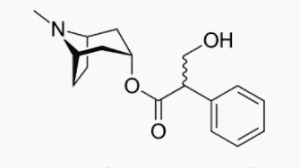STUDY RESULTS: USE OF ATROPINE TO CONTROL PROGRESSION OF MYOPIA
Myopia is one of the most common eye diseases in the world. It has also become the leading cause of blindness. In a study of 2.1 million participants, results suggest that approximately 2.7% of the world population has myopia.
The rate of children having myopia at early stages is also rapidly increasing at an epidemic rate. Although there are many ways to correct myopia easily, the increasing cases of myopia that turn to high myopia, and lead to partial blinding eye disease is alarming.

Many scientists predict that myopia prevalence can increase to 50% by 2050 which can then affect 4.8 billion people in the world. What this means that one in every two children can have myopia 30 years from now.
What is Myopia?
Myopia is characterized by a visual impairment in which an individual can only clearly see near objects while farther objects appear blurry. It is a multifactorial disease caused by the abnormal development of the eyeball. This disease happens when a person develops an irregularly shaped eyeball which causes light to bend incorrectly.
The most common form of myopia is axial myopia and is characterized by the secondary to elongation of the axial length of the eye. Most people choose to ignore the early stages of myopia but myopia is a serious eye disease that can progress and lead to potential blindness.
There is currently no surgery to cure myopia and the best treatment strategy is to control its progression. Myopia can be corrected with eyeglasses or contact lenses which help refocus light on the retina. Once the vision has stabilized, it can then be permanently treated with refractive surgery. LASIK is the cheapest and most popular surgical procedure.
Impacts of Myopia in Children
Myopia is currently the most common eye disease in children and adolescents. The cases are even more serious in East Asian regions where around 80-90% of young adults have myopia. Myopia can also affect the academic performance of children. As they grow older it also affects their psychological development. If left untreated, it could also affect their employment choices. Children who had myopia at an early age have a higher incidence of high myopia, greater risk of glaucoma, myopic maculopathy, retinal detachment, and choroidal neovascularization.
How Does Atropine Help Control Myopia Progression
There have been many studies on the development of myopia, but the cellular mechanisms involved are not well understood. This has been preventing the search for the best pharmacological control. The use of pharmaceutical interventions to mitigate the progress of myopia has always been most effective in comparison to other strategies.
The only drug that is known to be most effective is atropine, an anticholinergic blocking agent. Anticholinergics are drugs that “block the action of acetylcholine at the muscarinic receptors (MRs) on structures with parasympathetic innervation and smooth muscles”. Acetylcholine plays a key role in retina development and eye growth.
The exact mechanism of how atropine does this remains elusive and debatable but it does help mitigate the disease at multiple levels. It is then often categorized as a shotgun approach to myopia treatment.
Once a child develops myopia, progression is continuous and is estimated to be around -1D per year in east Asians and around -0.5 in Caucasians. If not given early intervention, a significant portion of these children will reach high myopia. Prevention of myopia in children is urgent and important.
The Study
There have been many studies on the effectiveness and safety of atropine but none discussing the most optimal dose until now. As published in BMC Ophthalmology (December, 2020), the study was done through data from MEDLINE, PubMed, EMBASE, and the Cochrane Central Register of Controlled Trials.
Methods
The meta-analysis of the prospective randomized controlled trials was performed according to the PRISMA statement.
Eligibility Criteria
Here are the following criteria used to choose included studies:
1) A randomized placebo-controlled clinical trials
2) Spherical equivalent refraction more than -0.25D measured by cycloplegic autorefraction
3) Patients under 18 years old
4) Use of atropine for at least 1 year
5) The study report at least the annual rate of myopia progression
Results
10 random control trials were used in the study. Results found that myopia progression was mitigated grater in the atropine treatment group than in the control group during the observation period.
MD = − 0.80, 95% CI (− 0.94, − 0.66)
There was also a statistical difference between 0.05, 0.5, and 1.0% atropine (P = 0.004). There was less axial elongation shown with MD = − 0.26, 95% CI (− 0.33, − 0.18) during the whole observation period.
The study also found that a low dose of atropine worsened the progression of myopia. When atropine was discontinued after a year of usage, myopia also progressed faster than the placebo group.
In a recent study follow-up observation (2 years after the study was conducted) in the United States, they found that 0.01% atropine effectively controlled the progression of myopia. This was also verified last year from the same study on 0.01% atropine although it didn’t stop the effectiveness of other doses.
Using the right dose can increase the effectiveness of atropine in controlling the progression of myopia. The optimal dose is 0.05% atropine.
Studies and Reports
Kinoshita reports that combined application of 0.01% atropine eye drops and orthokeratology can slow the axis elongation. This is compared to the use of orthokeratology alone. Another study published similar results but the elongation of the eye axis was found inapt to predict the progression of myopia accurately. Therefore, effectiveness should be further studied.
Experts also have found several other approaches that can help slow down the progression of myopia. Including an increase in outdoor activity and reduced work or study time.
Limitations of the Study
The study has several limitations. First, the meta-analysis had established strict inclusion and exclusion criteria and the heterogeneity was high even after using the subgroup analysis.
Another issue was that there are no studies that involve 0.01% of atropine. The few studies that talk about the progression of myopia after atropine was discontinued. This is why there needs to be further validation of the optimal dose.
Navigation
Ophthalmology Related Tables and Apps
- Ophthalmic anesthetics
- Ophthalmic Antibacterials and combination products
- Ophthalmic Anti-allergy agents
- Ophthalmic Antivirals
- Ophthalmic Corticosteroids
- Ophthalmic – Dry eye disease (DED)
- Ophthalmic – Glaucoma
- Ophthalmic Mydriatics
- Ophthalmic NSAIDs
Glaucoma
- Beta blockers
- Prostaglandin analogs
- Alpha-adrenergic agonists
- Carbonic anhydrase inhibitors
- Rho kinase (ROCK) inhibitors
- Fixed Combination Medications
- Preservative-Free Products
- Benzalkonium chloride (BAK)-Free products
- Comparative effectiveness of glaucoma drops
- New Glaucoma Drug Selection tool – Medical App
- Potency of Glaucoma drops – Medical App
- Glaucoma – BAK-free and Preservative-free drops Medical App
- Medical Treatment of Dry Eye Disease (Ophthalmic drops)- Medical App
Other
Latest Research

